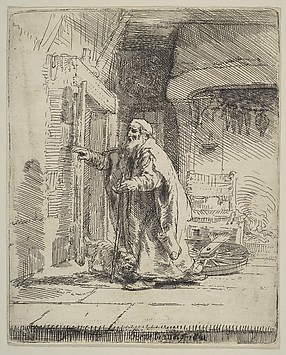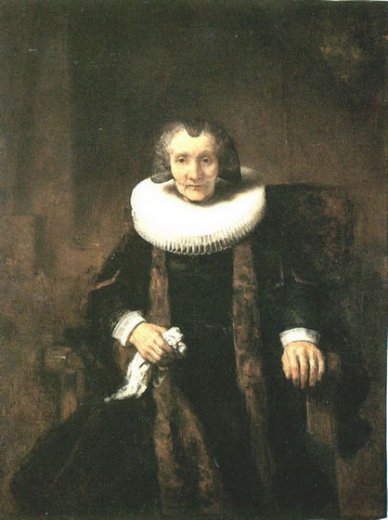Rembrandt van Rijn (1606-1669)
Rembrandt van Rijn was a Dutch artist, generally considered one of the greatest painters and printmakers in European art history and the most important in Dutch history.
Several researchers believe that Rembrandt may have had stereo blindness (dissimilar visual images received by his left and right eyes), since many of his self-portraits show each of his eyes looking in a different direction, as in Self-Portrait as a Young Man:




This lack of binocular vision may have caused problems with Rembrandt’s depth perception – but it also may have helped his art by making Rembrandt become exceptionally aware of light changes, shadows, and other details that helped him judge distances and depth and depict a realistic three-dimensional world on a flat canvas.
One of Rembrandt’s most famous paintings is The Night Watch (1642), known for its effective use of light, depth, shadow, and the perception of motion he created on the canvas:
https://www.khanacademy.org/humanities/monarchy-enlightenment/baroque-art1/holland/v/rembrandt-nightwatch
Who was Rembrandt van Rijn?
Although many of the historcal details of his life are unknown, it is known that Rembrandt Harmensz van Rijn was born in Leiden, the Netherlands on July 15, 1606, and that he died Rembrandt died in relative obscurity on October 4, 1669. Rembrandt was the ninth child in the family; his father was a miller and his mother came from a wealthy family. Around 1613-1615, Rembrandt attended the Latin School to prepare for his admission to Leiden University. While still living with his parents, he enrolled at the university in 1620, just before he turned 14. In 1622, at the age of 16, Rembrandt began a three-year apprenticeship with the Leiden painter Jacob Isaacsz van Swanenburg.
Rembrandt established his own studio in Leiden, and later settled in Amsterdam (around 1632). Rembrandt was quick at completing exquisitely detailed portraits, a type of work for which he soon became famous. He was also well-known for his self-portraits; many these were simple representations of himself in the background of more elaborate works. His self-portraits, more than 100 of them, provide an excellent visual choronology of his aging, as well as an account of changes in the execution of his work.
Rembrandt considered himself primarily a history painter. Despite the Church of Holland’s ban on religious paintings, agreat deal of his work dealt with Biblical subjects. Following in the path of the late 16th century Italian painter Caravaggio, Rembrandt used powerful light/dark contrasts (ie. chiaroscuro), used to highlight his subject and explore the depths of the human soul. Rembrandt was also an accomplished draughtsman and printmaker whose works were crafted with precision and in minute detail. He is generally considered to be the greatest Dutch painter of all time. Like some other great artists (eg. Michelangelo, Leonardo da Vinci, and Raphael) he adopted the practice of signing his works with a single name, “Rembrandt”.
Throughout his artistic life Rembrandt strived for authenticity and recorded what he saw around him them putting these compositions of ten as part of his 300 etchings or 2000 drawings into his 300 largely commissioned oil paintings.
Rembrandt included a number of disabled people in these drawings. Lepers had to wear a white head band and had had all their worldly goods confiscated by the state as they had been punished by God by acquiring their affliction.
Although there is no documented evidence regarding changes in Rembrandt’s vision, many of the changes in his work may well be the result of visual aging. Others may be the result of purposeful stylistic change. Rembrandt’s earlier works show him to be a master of detail and light sensitivity, or in visual terms, to have good acuity and contrast sensitivity. Judging from his works, his visual acuity and contrast sensitivity appeared to decline as he aged. Certainly, he would have experienced the universal age-related loss of the ability to focus near stimuli, (ie. presbyopia) in his middle years. Presbyopia would make it more difficult to engage in effectively in near visual tasks such as painting. It is also possible that in his later years, Rembrandt experienced visual loss caused by an age-related opacity of the lens of his eye (ie. cataract). Whatever their cause, notable visual changes appear to characterize Rembrandt’s later works. His later work appears to be reduced in detail, clarity and light sensitivity. The fine brush strokes and careful precision that are clearly evident in his early work, gave way to work that was loose, heavy, and less clearly-defined.
Compare, for example, Rembrandt’s depiction of the collar details in the paintings below, one from early in his career, the other painted late in his life. The fine detail seen in the collar from Lady and Gentleman in Black, painted when Rembrandt was 27, is absent from the collar in Margaretha de Geer, Wife of Jacob Trip, painted when Rembrandt was 53.
The effects of Rembrandt’s visual aging may also be apparent in his self-portrait painted in 1669 (right), painted in the last year of his life. The detail is minimal, the artist’s strokes are very broad, and the painting has a strong yellow cast, effects that are consistent with deteriorating vision. http://psych.ucalgary.ca/PACE/VA-Lab/AVDE-Website/rembrandt.html











